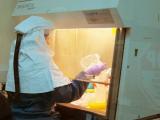Jan 6, 2003 (CIDRAP News) – Exotic Newcastle disease (END) has struck commercial poultry flocks in Southern California, causing quarantines in six counties and temporary Canadian and Mexican bans on poultry and poultry product imports from the area. Poultry is a $3 billion industry in California, and more than half the state's 12 million egg-producing hens are in the quarantine zone.
"This is an alarming situation that seriously threatens our poultry industry," William J. Lyons, Jr, secretary of the California Department of Food and Agriculture (CDFA), is quoted as saying in a Dec 30, 2002, press release from the department. He goes on to say that CDFA is working with the industry and the federal government to respond "quickly and decisively."
The disease was discovered in Los Angeles County in small backyard flocks in October 2002. Since then, outbreaks have been confirmed in several large commercial egg-laying facilities. Officials have ordered the slaughter of more than a million birds to date. The quarantine disallows transport out of the area of live birds or poultry products except for pasteurized eggs.
END is a viral disease, formerly known as velogenic viscerotropic Newcastle disease. It does not pose a threat to human health but is highly contagious and virulent among poultry, with a death rate of close to 100% in unvaccinated birds. Although infected birds may show no clinical symptoms, the disease can involve the respiratory, digestive, and nervous systems; a drop in egg production and production of thin-shelled eggs can occur, and sudden death is common.
A catastrophic outbreak of END in 1971, also in California, resulted in the destruction of nearly 12 million birds in 1,341 flocks. That outbreak was eradicated in 1974 at a total cost of $56 million. No commercial flocks have been infected since that time until the present outbreak. Transmission is from droppings and eye and beak secretions from infected birds. The infections spreads quickly through poultry kept in confined areas, such as commercially raised flocks. The disease is also easily spread mechanically by such factors as virus-bearing material on the shoes of vaccination crews, feed delivery personnel, and farm owners and employees The virus is destroyed by dehydration and sunlight but can survive several weeks in warm, humid conditions and indefinitely in frozen material.
The only way to eradicate the disease is by rapid destruction of infected birds and strict quarantine and surveillance. According to the US Department of Agriculture's Animal and Plant Health Inspection Service (APHIS), poultry farmers should strengthen their biosecurity measures to prevent the introduction of END into their flocks. APHIS works to contain the introduction of END into domestic flocks by requiring testing and quarantining of all imported birds and by stepped-up surveillance for outbreaks.
END is among the OIE (Office International des Epizooties) list A diseases. These are defined as transmissible diseases that have the potential for very serious and rapid spread, irrespective of national borders, that are of serious socioeconomic or public health consequence and that are of major importance in the international trade of animals and animal products.
Suspected cases should be reported immediately to state or federal animal health authorities.
For more information:
California Department of Food and Agriculture
CIDRAP Information: Exotic Newcastle Disease
Editor's Note: While there is no suggestion of agroterrorism in this outbreak, the rapidity of the disease's spread and the mounting economic consequences demonstrate the potential impact should such action ever occur.



















